Published for the Australian Military Forces by the Australian War Memorial, Canberra, in 1944. Full of sketches, poems, colour plates and photographs, cartoons and jokes, as well as those fabulous yarns that Aussies can tell so well - and all by the service personnel who were engaged in the South West Pacific during World War II. Contributors are identified only by their service numbers...so your grandfather or great grandfather may be among the authors. Here we do not find battle statistics, plans or generals - just the down to earth Australian Diggers.
- Sorry, this product is unavailable.
-
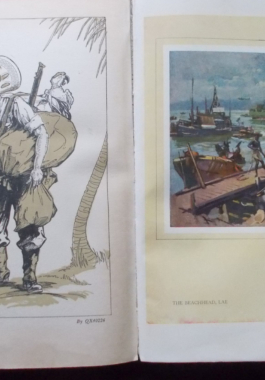
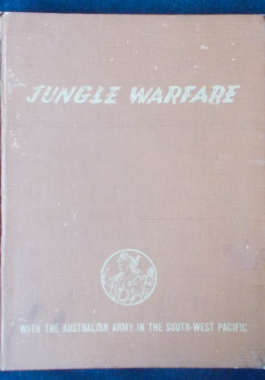
-
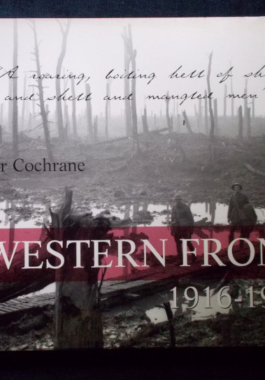 A fascinating, unsettling and unforgettable view of one of the most compelling events in modern history. For all the significance attached to the doomed heroism at Gallipoli, the Western Front was the single greatest wartime tragedy that elicited the greatest sacrifice. Of the 61,720 who died in the course of the war, 46,319 were lost at the Western Front. In a matter of weeks, more Australians were slain in or or two battles than in the entire eight months at Gallipoli. Those terrible years, 1916 to 1918, represent the whole panoply of modern warfare. This is an examination of the record of official and unofficial images in unexpected ways. It looks at the major battles of the campaign, the grim conditions endured by the soldiers, the workers of the massive support system, the valiant efforts of stretcher-bearers and medical workers and, finally, the run of victories under Monash in which Australian soldiers distinguished themselves above and beyond their numerical presence. Illustrated with black and white photographs.
A fascinating, unsettling and unforgettable view of one of the most compelling events in modern history. For all the significance attached to the doomed heroism at Gallipoli, the Western Front was the single greatest wartime tragedy that elicited the greatest sacrifice. Of the 61,720 who died in the course of the war, 46,319 were lost at the Western Front. In a matter of weeks, more Australians were slain in or or two battles than in the entire eight months at Gallipoli. Those terrible years, 1916 to 1918, represent the whole panoply of modern warfare. This is an examination of the record of official and unofficial images in unexpected ways. It looks at the major battles of the campaign, the grim conditions endured by the soldiers, the workers of the massive support system, the valiant efforts of stretcher-bearers and medical workers and, finally, the run of victories under Monash in which Australian soldiers distinguished themselves above and beyond their numerical presence. Illustrated with black and white photographs. -

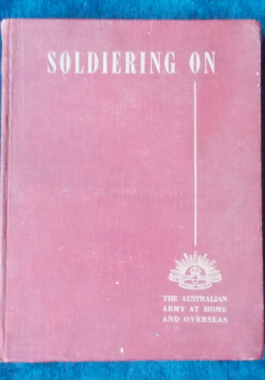
The Australian Army at Home and Overseas, by Some of the Boys and published by the Australian War Memorial, Canberra, 1942. Chapters include: Star Over Bethlehem; Diggers in Britain; Midnight Messiah; Purple's Pup; Arab Justice; Digger v. Doughboy and so much more. Our boys' impressions of Christmas in a cold climate and local customs as well as the American servicemen and women here in Australia. The colour plates, interestingly, are pasted in. Tales, jokes, sketches, cartoons and on-the-spot experiences a-plenty. Illustrated in colour and black and white. A treasure mine of information.
-
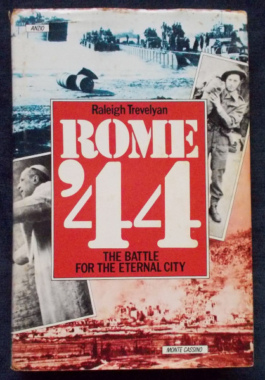 When the author, a wounded veteran of 21, arrived in Rome in 1944, the question most Italians asked him was: 'What took you so long?' What indeed? Were the Allied High Command to blame? Were the generals incompetent? Was the Anzio landing itself a tactical error? In 1956 Raleigh Trevelyan published, as The Fortress, the diaries he had surreptitiously kept in the Anzio trenches and, as a result, made contact with a number of Germans who had been only yards away from him twelve years earlier. Now that statesmen and generals have published their memoirs and official histories of the war have been written, it seems possible at long last to attempt an answer. This is a remarkable book, bringing together the skill and insight of an accomplished historian, the narrative drive of a gifted storyteller, and the rage and terror of a man experiencing at first hand the momentous events from Anzio to Monte Cassino and on to Rome. The reader follows the fate of the 'poor bloody infantry' on both sides of the line; sees a group of Romans adapting to the idea that the Germans are still there; penetrates the secrets of the Vatican; watches the Allied and German generals on the spot fight with their High Commands and hears what Hitler, Churchill, Roosevelt and Stalin thought about it at the time. Illustrated with black and white photographs and even some contemporary cartoons.
When the author, a wounded veteran of 21, arrived in Rome in 1944, the question most Italians asked him was: 'What took you so long?' What indeed? Were the Allied High Command to blame? Were the generals incompetent? Was the Anzio landing itself a tactical error? In 1956 Raleigh Trevelyan published, as The Fortress, the diaries he had surreptitiously kept in the Anzio trenches and, as a result, made contact with a number of Germans who had been only yards away from him twelve years earlier. Now that statesmen and generals have published their memoirs and official histories of the war have been written, it seems possible at long last to attempt an answer. This is a remarkable book, bringing together the skill and insight of an accomplished historian, the narrative drive of a gifted storyteller, and the rage and terror of a man experiencing at first hand the momentous events from Anzio to Monte Cassino and on to Rome. The reader follows the fate of the 'poor bloody infantry' on both sides of the line; sees a group of Romans adapting to the idea that the Germans are still there; penetrates the secrets of the Vatican; watches the Allied and German generals on the spot fight with their High Commands and hears what Hitler, Churchill, Roosevelt and Stalin thought about it at the time. Illustrated with black and white photographs and even some contemporary cartoons. -

The author, a TV reporter and journalist, has condensed his experiences and observations of the Indo-China battlefields over a thirty-five year period. Sights, sounds and smells come alive in the graphic and vivid recreation by a neutral yet passionately involved eye-witness. Scholl-Latour first traveled to South-East Asia on a troop-ship in 1945 and since then has covered three wars: the war against French colonialism, the American involvement in Vietnam and the final devastation of Kampuchea. He sees those years as a tragedy that has shattered every illusion of freedom as the French, the Americans and the Khmer Rouge each tried to impose their versions of freedom by force.
-
 World War II gave rise to an astonishing number of unorthodox 'special forces' yet this is the first book to assess their contribution to the final victory or how they related to one another and to the more conventional fighting forces. In 1939 'Special Forces' did not exist; it was Churchill who ordered them to 'set Europe ablaze'. Operating under the cloak of secrecy during wartime and quickly disbanding after it they have not often received credit for their achievements. From early 'butcher and bolt' raids by parachutists and commandos to SOE activities in the Balkans and France; 'Merrill's Marauders' and Windgate's Chindits in Burma, Special Forces were active in all great theatres of war. They played a vital role in intelligence-gathering, Anglo-American co-operation, sabotage, the fostering of local resistance movements and guerilla fighting. They denied 'heavy water' to Germany, making it impossible for that country to manufacture an atomic bomb and crucially affected the balance of air power in the Western Desert in 1942. Here are survivors' stories - courageous men and women, many of whom have become legendary. With black and white photographs.
World War II gave rise to an astonishing number of unorthodox 'special forces' yet this is the first book to assess their contribution to the final victory or how they related to one another and to the more conventional fighting forces. In 1939 'Special Forces' did not exist; it was Churchill who ordered them to 'set Europe ablaze'. Operating under the cloak of secrecy during wartime and quickly disbanding after it they have not often received credit for their achievements. From early 'butcher and bolt' raids by parachutists and commandos to SOE activities in the Balkans and France; 'Merrill's Marauders' and Windgate's Chindits in Burma, Special Forces were active in all great theatres of war. They played a vital role in intelligence-gathering, Anglo-American co-operation, sabotage, the fostering of local resistance movements and guerilla fighting. They denied 'heavy water' to Germany, making it impossible for that country to manufacture an atomic bomb and crucially affected the balance of air power in the Western Desert in 1942. Here are survivors' stories - courageous men and women, many of whom have become legendary. With black and white photographs. -
 "Learn all you can about the German Army and one day you will be a valuable man to your country." These words were spoken to young Alexander Scotalnd by Major Wade, a British liaison officer in German West Africa in 1904. He never forgot those words. This book covers how much he learnt and how valuable were his services to his country. This young man served in the German Army - at the suggestion of the Germans - for the duration of the Hottentot Rebellion, thereby gaining an intimate knowledge of the organisation and strengths of the German military machine. He grew to know, by close contact, the habits, language and mental outlook of the German soldier. This knowledge was the basis of his achievements in espionage, interrogation and undercover work in two world wars. His reputation led to a strange meeting with Adolf Hitler in 1937, at the home of a mutual friend. His career reached its zenith in 1947 when - as Chief Officer of the War Crimes Investigation Unit, he played a decisive role in bringing Nazi war criminals to justice. Illustrated with black and white photographs.
"Learn all you can about the German Army and one day you will be a valuable man to your country." These words were spoken to young Alexander Scotalnd by Major Wade, a British liaison officer in German West Africa in 1904. He never forgot those words. This book covers how much he learnt and how valuable were his services to his country. This young man served in the German Army - at the suggestion of the Germans - for the duration of the Hottentot Rebellion, thereby gaining an intimate knowledge of the organisation and strengths of the German military machine. He grew to know, by close contact, the habits, language and mental outlook of the German soldier. This knowledge was the basis of his achievements in espionage, interrogation and undercover work in two world wars. His reputation led to a strange meeting with Adolf Hitler in 1937, at the home of a mutual friend. His career reached its zenith in 1947 when - as Chief Officer of the War Crimes Investigation Unit, he played a decisive role in bringing Nazi war criminals to justice. Illustrated with black and white photographs. -
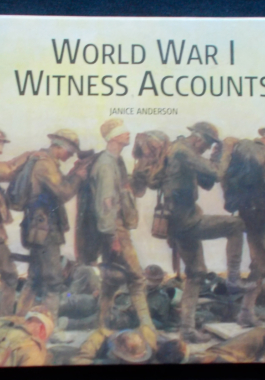 You can read history - or you can learn history from the people who lived it. This compilation of accounts of life during the First World War are from diaries and letters: from those at home, from the trenches, from men and women in the armed forces...there's even a section devoted to the modern machineries of war and what those on the front line thought of them. Here are the voices of that time and they are the ones who know what life was like then.
You can read history - or you can learn history from the people who lived it. This compilation of accounts of life during the First World War are from diaries and letters: from those at home, from the trenches, from men and women in the armed forces...there's even a section devoted to the modern machineries of war and what those on the front line thought of them. Here are the voices of that time and they are the ones who know what life was like then. -
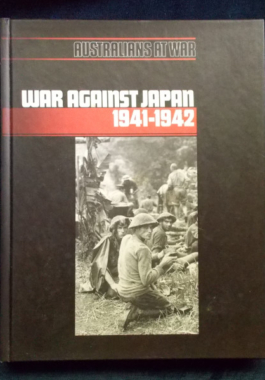 Time-Life series Australians At War, Volume 1. In South East Asia the European colonists lived an indolent life while to the north, the Japanese marched hungrily to war. In Singapore and up-country Malaya, there was still time for socialising and for serving officers to deck themselves out in their mess-dress finery for balls and dances, and for their wives to enjoy all the comforts that colonial service and a strong pound sterling could bring. Garrison life was an endless round of parties, parades and presentations at Government House. But with the splendour, there was a blind refusal in London and the Far East to see just how expansionist and bellicose the Japanese really were. Lavishly illustrated with archival black and white photographs and colour reproductions of contempory art.
Time-Life series Australians At War, Volume 1. In South East Asia the European colonists lived an indolent life while to the north, the Japanese marched hungrily to war. In Singapore and up-country Malaya, there was still time for socialising and for serving officers to deck themselves out in their mess-dress finery for balls and dances, and for their wives to enjoy all the comforts that colonial service and a strong pound sterling could bring. Garrison life was an endless round of parties, parades and presentations at Government House. But with the splendour, there was a blind refusal in London and the Far East to see just how expansionist and bellicose the Japanese really were. Lavishly illustrated with archival black and white photographs and colour reproductions of contempory art. -

Fire One! Hugh Clarke
$30.00Two true war time stories of Australia: Japanese midget submarines attacked Sydney Harbour in 1942, stunning Australia with their preparations, strategy and the aftermath - an attack that could have paved the way for the first wartime invasion in Australia's history. The greatest mass escape of prisoners-of-war in British milirtary history took place in the small country town of Cowra in 1944. The attempt was hopeless - 231 Japanese and 4 Australians were killed. Illustrated with black and white photographs. -
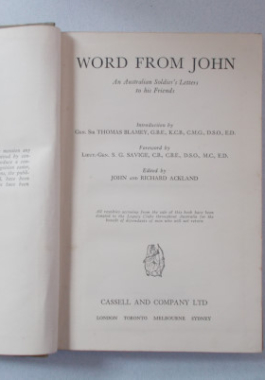
An Australian soldier's letters to his friends from World War II. When written, these letters did not mention place names other than those permitted by the censor. In order to make a continuous and intelligible narrative, these place names (now permitted) have been inserted. A rare glimpse from the war front.
-
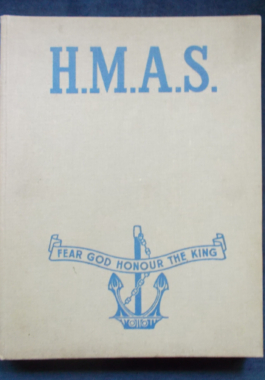 From the foreword: H.M.A.S. is the first attempt to give to the men of the Royal Australian Navy and to Australians generally, a story in some connected form, leavened by the thoughts and experiences of the actors themselves... Here is their story, told by the men themselves: war stories, funny stories, cartoons, paintings and photographs, all of which express the range of emotions these men felt and experienced. With colour plates tipped-in (as at publication), black and white sketches and photographs. A real treasure for those interested in the stories of everyday men that were not often heard. Here is the chance to listen to them tell it as it really was.
From the foreword: H.M.A.S. is the first attempt to give to the men of the Royal Australian Navy and to Australians generally, a story in some connected form, leavened by the thoughts and experiences of the actors themselves... Here is their story, told by the men themselves: war stories, funny stories, cartoons, paintings and photographs, all of which express the range of emotions these men felt and experienced. With colour plates tipped-in (as at publication), black and white sketches and photographs. A real treasure for those interested in the stories of everyday men that were not often heard. Here is the chance to listen to them tell it as it really was. -
 Published by the Dachau Museum, this book serves as a reminder of the victims of the Holocaust. It contains reproductions of official documents, anti-Semitic propoganda, photos of the camps, the prisoners and their few possessions that we callously stolen from them; letters of condolence from Camp Commandants to grieving widows, records of military personnel and so much more.
Published by the Dachau Museum, this book serves as a reminder of the victims of the Holocaust. It contains reproductions of official documents, anti-Semitic propoganda, photos of the camps, the prisoners and their few possessions that we callously stolen from them; letters of condolence from Camp Commandants to grieving widows, records of military personnel and so much more. -
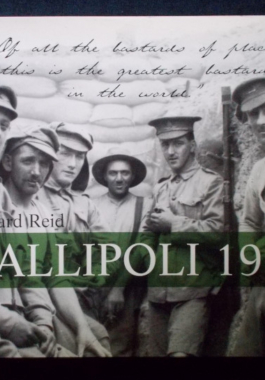
Gallipoli 1915: Richard Reid
$15.00A new look at the old legend of Anzac - an account of how ordinary blokes from many different countries coped in extraordinary circumstances not only in battle but back in the trenches. These men, whose fingers were too frozen to pull the trigger, buried their best mates, slept in holes in the ground and struggled with lice infested clothes. This book presents a remarkable and absorbing series of photographs from Australia's major archival collections, many previously unseen. These images often taken by the soldiers themselves, combined with illustrations created for the newspapers, were the images responsible for creating the public memory of Gallipoli back in Australia. The commentary of historian, Dr Richard Reid of the Department of Veterans' Affairs, together with moving extracts from soldiers letters and diaries, along with the official dispatches of war correspondents present at Gallipoli, paint an unforgettable record of the sacrifices, courage and determination embodied in the Anzac legend. -

The author has written the full length story of the Malayan campaign of World War II from the 'sharp end' of the fighting and as a prisoner-of-war, one of thousands who suffered for three years. He takes the reader through bewildering, disordered days and nights of fighting to humiliation at the hands of the Japanese, versed in all the arts of abasing and breaking prisoners by starvation and neglect. The illustrations by fellow prisoner Ronald Searle (St. Trinians, Down With Skool,Whizz For Atomms, How To Be Top, etc.) are poignant, forceful and make reality even more real. This really is war and imprisonment as it happened.
-
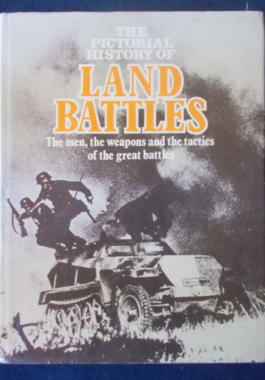 A book full of information, pictures and maps of land battles throughout history that proves it was not always about who had the biggest army. In this volume - Metaurus - after the toughest forced march in history, Nero slays Hasdrubal; Agincourt - massed archers and infantry slaughter the French cavalry; Bunker Hill - a thousand farmers ignite the flame of American independence; Austerlitz - Napoleon crushes an army bigger than his own; Balaclava - a battle of idiocy and sheer courage; Second Bull Run - a high spot for the South in the American Civil War; The Somme - slaughter on a scale never seen before or since; Cambrai - tanks explode into action for the first time; Gazala - Rommels' fast moving tactical brilliance; Stalingrad - Hitler's obstinacy leads the Wehrmacht to disaster; Cassino and Anzio - Allied forces combine to force a breakthrough; The Battle Of The Bulge - fast moving Panzers against Eisenhower, Montgomery and Patton; Operation Commando - a true 'United Nations; against the Chinese in Korea. Illustrated with archival photographs, artists' representations and maps.
A book full of information, pictures and maps of land battles throughout history that proves it was not always about who had the biggest army. In this volume - Metaurus - after the toughest forced march in history, Nero slays Hasdrubal; Agincourt - massed archers and infantry slaughter the French cavalry; Bunker Hill - a thousand farmers ignite the flame of American independence; Austerlitz - Napoleon crushes an army bigger than his own; Balaclava - a battle of idiocy and sheer courage; Second Bull Run - a high spot for the South in the American Civil War; The Somme - slaughter on a scale never seen before or since; Cambrai - tanks explode into action for the first time; Gazala - Rommels' fast moving tactical brilliance; Stalingrad - Hitler's obstinacy leads the Wehrmacht to disaster; Cassino and Anzio - Allied forces combine to force a breakthrough; The Battle Of The Bulge - fast moving Panzers against Eisenhower, Montgomery and Patton; Operation Commando - a true 'United Nations; against the Chinese in Korea. Illustrated with archival photographs, artists' representations and maps. -
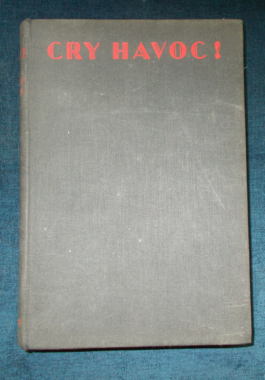
Cry Havoc! Beverley Nichols
$45.00Written in 1933, this book caused furor in many quarters. It's a far cry from Nichols' usual light-hearted badinage, being a bitter denunciation of the world's attitude toward peace and war and a thorough research into the activities of offensive preparations going on in the armament factories in England and on the Continent. It also covers the ineffectual preparations being made for defensive measures. Faced with the fact that war was brewing, the League of Nations was rendered virtually impotent through the media of the day and public opinion and that the civilian population is certain to be the victim in the next European War, his findings are far from negligible. The last half of the book is a succession of challenging dialogues, in which socialism, capitalism, militarism and pacifism are all given ardent advocates. Time and events demonstrated that Nichols predicted how World War II would proceed with uncanny 99% accuracy. -

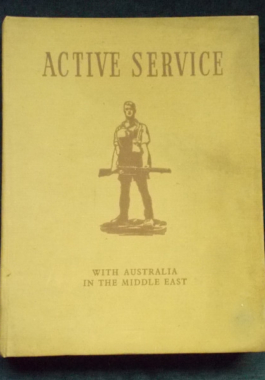 An illustrated notebook on the life of Australians in the Middle East theatre of war. Almost all of the contents are the work of men on active service, as well as reports on most of the action in which Australian forces had taken part up until 1941. With black and white and colour illustrations as well as black and white photographs, contents include: "Little Syd"; Hitler In London; Life In The 'Octu'; Visit To A 'Kibbutz'; Ernie Was A Cook and many more. There's comical articles and musings, men interested in the exotic life around them - and poems that define the yearning for home and loved ones.
An illustrated notebook on the life of Australians in the Middle East theatre of war. Almost all of the contents are the work of men on active service, as well as reports on most of the action in which Australian forces had taken part up until 1941. With black and white and colour illustrations as well as black and white photographs, contents include: "Little Syd"; Hitler In London; Life In The 'Octu'; Visit To A 'Kibbutz'; Ernie Was A Cook and many more. There's comical articles and musings, men interested in the exotic life around them - and poems that define the yearning for home and loved ones. -
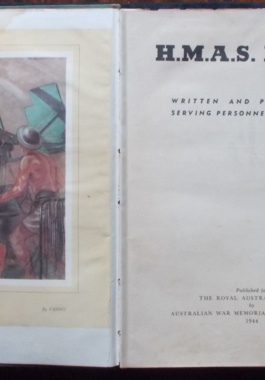
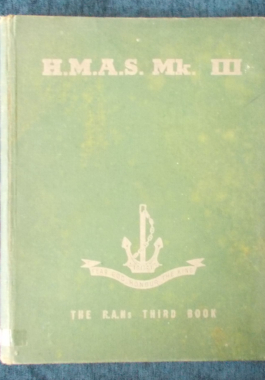
Published for the Royal Australian Navy buy the Australian War Memorial, Canberra in 1944. A book chockful of fabulous artwork, sketches, photographs, poems, writings and memoirs of the serving personnel of the Royal Australian Navy and their service in World War II - the men who were there as it all happened. A must for any real war buff. Illustrated in black and white and colour.
-
 New Zealand's most famous RAF pilot saw action from the Munich Crisis to the invasion of France in 1944. Deere experienced the drama of the early days of the Battle of Britain while serving with Spitfire squadrons based at Hornchurch and Manston, and his compelling story tells of the successes and frustrations of those critical weeks. Deere's nine lives are the accounts of his fantastic luck in escaping from seemingly impossible situations. During the Battle of Britain he parachuted from stricken aircraft on three occasions and once was blown up by a bomb while taking off from Hornchurch during an attack on the airfield. In March 1943 Deere was appointed Wing Commander of the famous Biggin Hill Wing and by the end of the war, his distinguished 'score' was destroyed - twenty-two; 'probables' - ten and damaged - eighteen. Illustrated with black and white photographs.
New Zealand's most famous RAF pilot saw action from the Munich Crisis to the invasion of France in 1944. Deere experienced the drama of the early days of the Battle of Britain while serving with Spitfire squadrons based at Hornchurch and Manston, and his compelling story tells of the successes and frustrations of those critical weeks. Deere's nine lives are the accounts of his fantastic luck in escaping from seemingly impossible situations. During the Battle of Britain he parachuted from stricken aircraft on three occasions and once was blown up by a bomb while taking off from Hornchurch during an attack on the airfield. In March 1943 Deere was appointed Wing Commander of the famous Biggin Hill Wing and by the end of the war, his distinguished 'score' was destroyed - twenty-two; 'probables' - ten and damaged - eighteen. Illustrated with black and white photographs. -
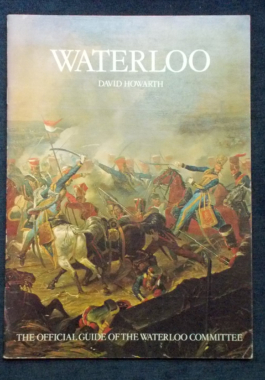 Believed to be the first guide to the battlefield written in English by an English writer, who is probably also the greatest living expert on Waterloo. There's descriptions of the battle location, weaponry and tactics that were all implement in a few hours on June 187, 1815. Illustrated.
Believed to be the first guide to the battlefield written in English by an English writer, who is probably also the greatest living expert on Waterloo. There's descriptions of the battle location, weaponry and tactics that were all implement in a few hours on June 187, 1815. Illustrated. -
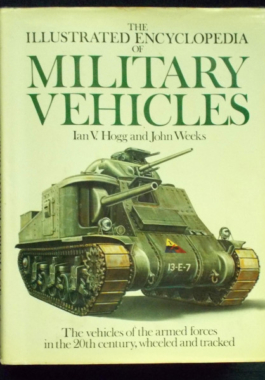 The use and development of motorised vehicles by the armed forces of the twentieth century is a complex and fascinating subject. While many books are devoted specifically to tanks, trucks and so on, this lavishly illustrated and comprehensive encyclopedia sets out to provide a complete and authoritative guide to motorised military vehicles of all categories - from the first quadricycles and armoured cars of the late nineteenth and early twentieth century to the 1980s. https://cosmiccauldronbooks.com.au/p/biography-general-george-s-patton-ian-v-hogg/
The use and development of motorised vehicles by the armed forces of the twentieth century is a complex and fascinating subject. While many books are devoted specifically to tanks, trucks and so on, this lavishly illustrated and comprehensive encyclopedia sets out to provide a complete and authoritative guide to motorised military vehicles of all categories - from the first quadricycles and armoured cars of the late nineteenth and early twentieth century to the 1980s. https://cosmiccauldronbooks.com.au/p/biography-general-george-s-patton-ian-v-hogg/ -
 As we crowded the decks off Gallipoli and watched the first shells crash into Turkish soil... Trooper Ion L. Idriess of the 5th Australian Light Horse began keeping a diary. Over the next three years as the regiment moved onto Palestine, stormed Beersheba and pushed into the Sinai, his diary grew and became one of the most vivid pieces of war narrative ever written. Unconcerned with grand strategy or moralisations, Idriess records the realities of his war - maggot-ridden trenches crowded with the corpses of his mates, the good friendships, the bad tucker, the heat, the dust, the boredom of desert patrols - and always the fighting and his reactions to it, which reveal far better than mere description, since he was there. The rifle fire grew to a roar that drowned the voice of the man next to me. I felt as a stone age man might feel if volcanoes all around him suddenly spat life and roared...Believed to be Idriess' earliest work.
As we crowded the decks off Gallipoli and watched the first shells crash into Turkish soil... Trooper Ion L. Idriess of the 5th Australian Light Horse began keeping a diary. Over the next three years as the regiment moved onto Palestine, stormed Beersheba and pushed into the Sinai, his diary grew and became one of the most vivid pieces of war narrative ever written. Unconcerned with grand strategy or moralisations, Idriess records the realities of his war - maggot-ridden trenches crowded with the corpses of his mates, the good friendships, the bad tucker, the heat, the dust, the boredom of desert patrols - and always the fighting and his reactions to it, which reveal far better than mere description, since he was there. The rifle fire grew to a roar that drowned the voice of the man next to me. I felt as a stone age man might feel if volcanoes all around him suddenly spat life and roared...Believed to be Idriess' earliest work. -
 Illustrated with over 1300 photographs, some never previously published, this military journey begins with the build up to war and the invasion of Poland to ultimate victory over Japan. Immensely readable, it brings the events and the people of those turbulent times into sharp focus for those who lived through the conflict as well as those born during the fifty years that have elapsed since the war's end.
Illustrated with over 1300 photographs, some never previously published, this military journey begins with the build up to war and the invasion of Poland to ultimate victory over Japan. Immensely readable, it brings the events and the people of those turbulent times into sharp focus for those who lived through the conflict as well as those born during the fifty years that have elapsed since the war's end. -
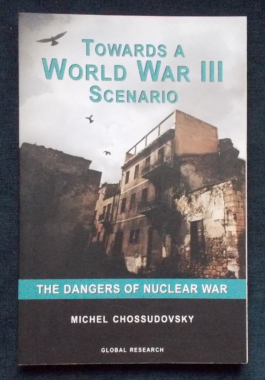 The author is a Professor of Economics and Director of the Centre for Research on Globalisation. This book has been rated and reviewed as a "...'must' resource - a richly documented and systematic diagnosis of the...planning of U.S. Wars since 9-11" "...one of the most important books currently available...the information is heart rending, scary and absolutely accurate." ...a hard-hitting and compelling book (which) explains why and how we must undertake a concerted...campaign to head off the impending cataclysmic demise of the human race and planet Earth."
The author is a Professor of Economics and Director of the Centre for Research on Globalisation. This book has been rated and reviewed as a "...'must' resource - a richly documented and systematic diagnosis of the...planning of U.S. Wars since 9-11" "...one of the most important books currently available...the information is heart rending, scary and absolutely accurate." ...a hard-hitting and compelling book (which) explains why and how we must undertake a concerted...campaign to head off the impending cataclysmic demise of the human race and planet Earth." -
 A volume of military activity, weaponry and technology from 1987. Arenas of activity covered: The Middle East - Tripoli; Lebanon; the Gulf War; South Yemen and the Arab-Israeli conflict. Europe, North America and the Soviet Union: Terrorism and Power Politics; The Superpower Relationship; NATO and the Warsaw Pact; International Terror; Northern Ireland. Asia - Islam's Guerrillas; The Tamil Tigers; The Philippines; Vietnam and Cambodia' Sikh Separatists. Africa - South Africa; Mozambique; Angola; Chad; The Sudan; Ethiopia; The Boy Soldiers of Uganda. Latin America: Guerrillas and Contras; El Salvador; Nicaragua; Peru; Chile. Military Technology: The War Machine; Aerial Warfare; Space and Missiles; Land Warfare; Naval Warfare. A wealth of information for the war history buff with plenty of colour photographs.
A volume of military activity, weaponry and technology from 1987. Arenas of activity covered: The Middle East - Tripoli; Lebanon; the Gulf War; South Yemen and the Arab-Israeli conflict. Europe, North America and the Soviet Union: Terrorism and Power Politics; The Superpower Relationship; NATO and the Warsaw Pact; International Terror; Northern Ireland. Asia - Islam's Guerrillas; The Tamil Tigers; The Philippines; Vietnam and Cambodia' Sikh Separatists. Africa - South Africa; Mozambique; Angola; Chad; The Sudan; Ethiopia; The Boy Soldiers of Uganda. Latin America: Guerrillas and Contras; El Salvador; Nicaragua; Peru; Chile. Military Technology: The War Machine; Aerial Warfare; Space and Missiles; Land Warfare; Naval Warfare. A wealth of information for the war history buff with plenty of colour photographs.




